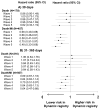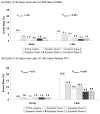Twenty-year evolution of percutaneous coronary intervention and its impact on clinical outcomes: a report from the National Heart, Lung, and Blood Institute-sponsored, multicenter 1985-1986 PTCA and 1997-2006 Dynamic Registries
- PMID: 20031687
- PMCID: PMC3024012
- DOI: 10.1161/CIRCINTERVENTIONS.108.825323
Twenty-year evolution of percutaneous coronary intervention and its impact on clinical outcomes: a report from the National Heart, Lung, and Blood Institute-sponsored, multicenter 1985-1986 PTCA and 1997-2006 Dynamic Registries
Abstract
Background: Percutaneous coronary intervention (PCI) has undergone rapid progress, both in technology and adjunct therapy. However, documentation of long-term temporal trends in relation to contemporary practice is lacking.
Methods and results: We analyzed PCI use and outcomes in 8976 consecutive patients in the multicenter, National Heart, Lung, and Blood Institute-sponsored 1985-1986 percutaneous transluminal coronary angioplasty (PTCA) and 1997-2006 Dynamic Registries waves (wave 1: 1997-1998, bare-metal stents; wave 2: 1999, uniform use of stents; wave 3: 2001-2002, brachytherapy; waves 4 and 5: 2004-2006, drug-eluting stents). Patients undergoing PCI in the recent waves were older and more often reported comorbidities than those in the balloon era. PCI was more often performed for acute coronary syndromes and, in spite of the greater disease burden, was more often selective. Procedural success was achieved and maintained more often in the stent era. Significant reductions were observed in in-hospital rates (%) of myocardial infarction (PTCA Registry: 4.9; wave 1, 2.7; wave 2, 2.8; wave 3, 1.9; wave 4, 2.6; wave 5, 2; P(trend)<0.001) and emergency coronary artery bypass surgery (PTCA Registry: 3.7; wave 1, 0.4; wave 2, 0.4; wave 3, 0.3; wave 4, 0.4; wave 5, 0; P(trend)<0.001). Compared with the PTCA Registry, risk for repeat revascularization (31 to 365 days after index PCI) was significantly lower in the dynamic waves (adjusted hazard ratio: wave 1, 0.72; wave 2, 0.51; wave 3, 0.51; wave 4, 0.30; wave 5, 0.36; P<0.05 for all).
Conclusions: Percutaneous interventions, in the last 2 decades, have evolved to include more urgent, comorbid cases, despite achieving high success rates with significantly reduced need for repeat revascularization.
Conflict of interest statement
Kevin E Kip: None
Faith Selzer: None
Robert L Wilensky: Grant support from Boston Scientific (<$10K) and Ownership Interests in Johnson & Johnson (>$10K)
James Slater: None
Suresh R Mulukutla: None
Oscar C Marroquin: None
Peter C Block: None
David O. Williams: Grant support from Cordis Corporation, Boston Scientific, and Abbott Vascular (all <$10K) and Consultant/advisory board of Cordis Corporation (<$10K);
Sheryl F Kelsey: None
Figures



Comment in
-
The first generation of angioplasty.Circ Cardiovasc Interv. 2009 Feb;2(1):1-3. doi: 10.1161/CIRCINTERVENTIONS.109.849950. Circ Cardiovasc Interv. 2009. PMID: 20031685 No abstract available.
References
-
- Gruntzig A. Transluminal dilatation of coronary-artery stenosis. Lancet. 1978;1:263. - PubMed
-
- Beohar N, Davidson CJ, Kip KE, Goodreau L, Vlachos HA, Meyers SN, Benzuly KH, Flaherty JD, Ricciardi MJ, Bennett CL, Williams DO. Outcomes and complications associated with off-label and untested use of drug-eluting stents. JAMA. 2007;297:1992–2000. - PubMed
-
- Laskey WK, Yancy CW, Maisel WH. Thrombosis in Coronary Drug-Eluting Stents: Report From the Meeting of the Circulatory System Medical Devices Advisory Panel of the Food and Drug Administration Center for Devices and Radiologic Health, December 7–8, 2006. Circulation. 2007;115:2352–2357. - PubMed
-
- Williams DO, Holubkov R, Yeh W, Bourassa MG, Al Bassam M, Block PC, Coady P, Cohen H, Cowley M, Dorros G, Faxon D, Holmes DR, Jacobs A, Kelsey SF, King SB, III, Myler R, Slater J, Stanek V, Vlachos HA, Detre KM. Percutaneous coronary intervention in the current era compared with 1985–1986: the National Heart, Lung, and Blood Institute Registries. Circulation. 2000;102:2945–2951. - PubMed
-
- Laskey WK, Williams DO, Vlachos HA, Cohen H, Holmes DR, King SB, III, Kelsey SF, Slater J, Faxon D, Al Bassam M, Block E, Detre KM. Changes in the practice of percutaneous coronary intervention: a comparison of enrollment waves in the National Heart, Lung, and Blood Institute (NHLBI) Dynamic Registry. Am J Cardiol. 2001;87:964–969. - PubMed
Publication types
MeSH terms
Substances
Grants and funding
LinkOut - more resources
Full Text Sources
Miscellaneous

